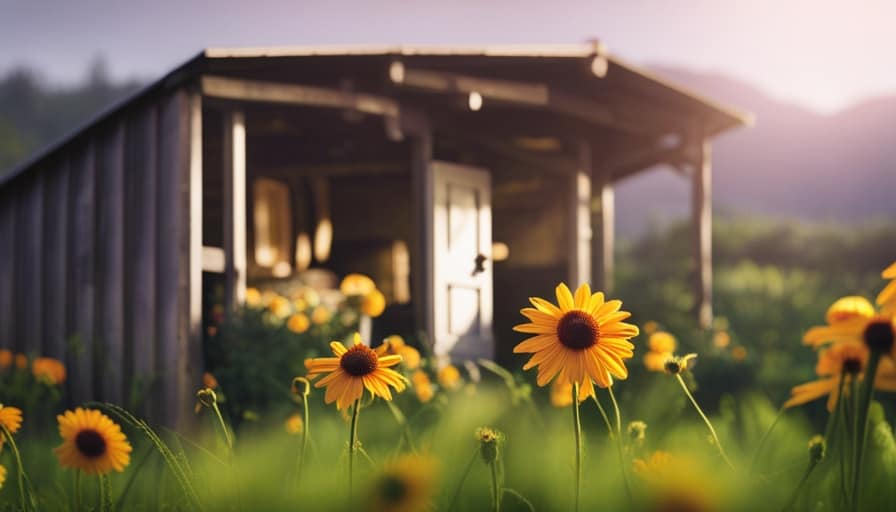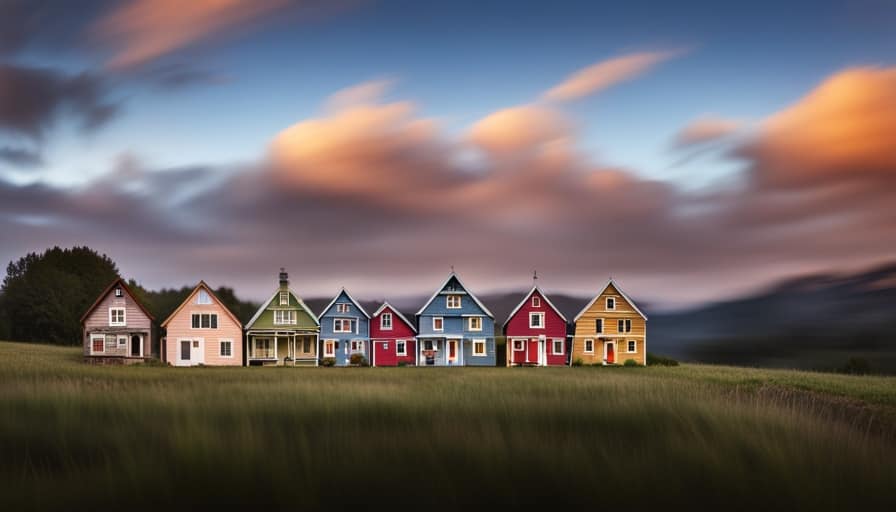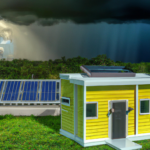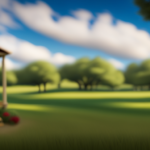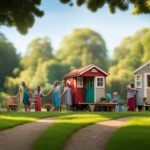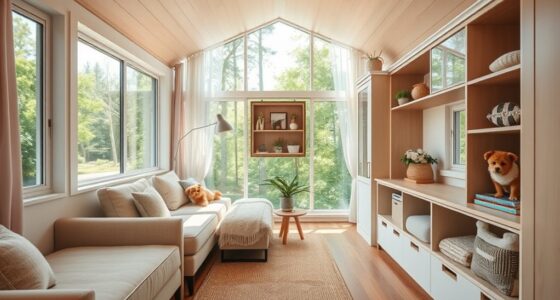Welcome to our list of the top 10 tiny house communities! Prepare to explore these distinct and flourishing neighborhoods.
From The Pocket Community to The Tiny House Waterfront Village, each community offers a distinct lifestyle and sense of community.
Explore the sustainable practices, artistic vibes, and wellness sanctuaries that make these communities so special.
Whether you’re seeking an eco-friendly oasis or a minimalist village, these tiny house communities are sure to inspire and serve your desire for a simpler, more connected way of living.

Key Takeaways
- The Pocket Community and The Sustainable Village prioritize connection, collaboration, and sustainable practices in tiny house living.
- Tiny House Communities like The Artistic Haven celebrate artistic expression and foster collaboration among artists.
- Unique designs and features in tiny house communities maximize space, promote collaboration among artists, and create an open and airy feel.
- Sustainable practices in tiny house communities include sustainable transportation, zero waste lifestyle, energy-efficient practices, water conservation, and community garden initiatives.
The Pocket Community
We love exploring the concept of the pocket community, where individuals come together to create a close-knit neighborhood of tiny houses. In these intentional living communities, residents prioritize connection and collaboration, fostering a sense of belonging and support.
Pocket communities are designed to promote interaction among neighbors, with shared outdoor spaces and common facilities that encourage socializing and cooperation. The small size of the houses promotes a minimalist lifestyle, encouraging residents to live with less and focus on what truly matters. These communities often emphasize sustainable practices, such as renewable energy sources and water conservation.
The pocket community concept is a beautiful example of how intentional living can create a sense of community and shared purpose.
Transitioning into the subsequent section about ‘the sustainable village’, it’s important to note that these communities also prioritize environmental stewardship.
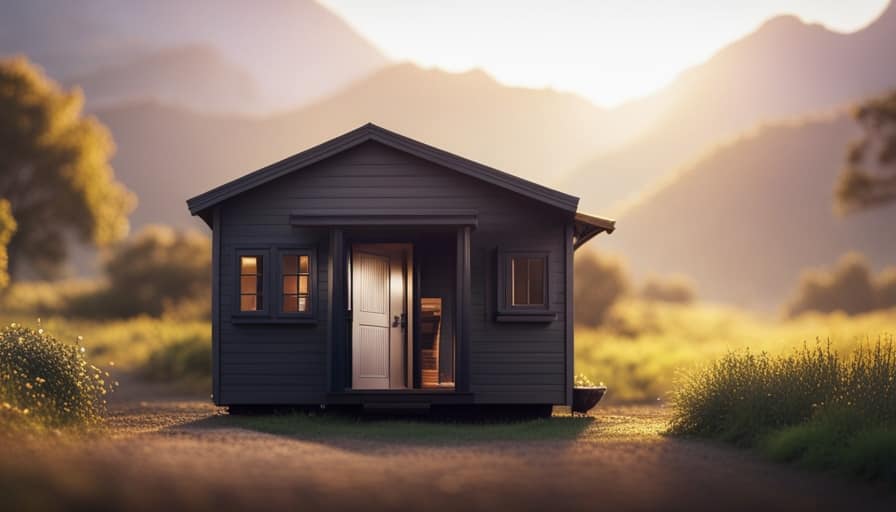
The Sustainable Village
Our sustainable village aims to create an environmentally conscious community that prioritizes renewable resources and practices. We believe in living a self-sufficient homestead lifestyle and embracing an eco-conscious way of life. In our village, we strive to be completely self-reliant by harnessing renewable energy, growing our own food, and conserving water. We have implemented various sustainable initiatives, such as composting and recycling programs, to minimize waste and reduce our carbon footprint. Our residents actively participate in community gardens, where we cultivate organic produce and share the harvest with one another. By living in our sustainable village, we not only contribute to the preservation of the environment but also foster a sense of community and collaboration, creating a fulfilling and purposeful life.
| Benefits | Features |
|---|---|
| 1. Reduced environmental impact | 1. Solar panels for energy generation |
| 2. Self-sufficiency | 2. Rainwater harvesting systems |
| 3. Community support and collaboration | 3. Organic community gardens |
| 4. Cost-effective living | 4. Sustainable waste management programs |
The Artistic Haven
When it comes to The Artistic Haven, creativity thrives in these tiny house communities. Residents have the opportunity to express their artistic talents through various mediums, from painting and sculpture to music and performance.
The unique aesthetics and designs of these homes serve as inspiration for collaboration among artists, fostering a sense of community and encouraging the exchange of ideas.
Creative Expression in Community
Within our vibrant community, we actively encourage and celebrate creative expression in various forms. Collaborative projects are a cornerstone of our community, where individuals come together to share their talents and create something unique. We believe that cultural diversity enriches our artistic endeavors, allowing us to explore different perspectives and styles.

Whether it’s painting, sculpture, music, or dance, there’s always a space for residents to express themselves and showcase their creativity. Through workshops, exhibitions, and performances, we foster an environment that supports and nurtures artistic growth. Our community values the power of art to connect people and promote understanding.
As we delve into the next section about unique aesthetics and designs, we continue to embrace the spirit of creative expression and the beauty it brings to our tiny house community.
Unique Aesthetics and Designs
Embracing the diverse talents and passions of our residents, we revel in the unique aesthetics and designs that transform our tiny house community into an artistic haven. Our residents have truly embraced the concept of maximizing space in their tiny house interiors. With the use of space-saving furniture, they’ve created functional and stylish living spaces that are a testament to their creativity and ingenuity.
Here are some of the unique features that make our tiny houses stand out:

- Cleverly designed loft spaces that provide additional sleeping areas without sacrificing precious floor space.
- Foldable and multi-purpose furniture pieces that can be easily transformed to adapt to different needs.
- Creative storage solutions, such as built-in shelves and hidden compartments, that maximize storage space in a compact environment.
- Thoughtful use of natural light and strategic placement of windows to create an open and airy feel in our tiny houses.
In our community, every tiny house is a work of art, showcasing the endless possibilities of living small without compromising on style and comfort.
Inspiring Collaboration Among Artists
In our artistic haven, we foster collaboration among artists through shared workspaces and regular creative workshops. Our goal is to create an environment that encourages artists to come together, share their ideas, and work on collaborative projects.
By providing shared workspaces, artists have the opportunity to connect with others who share similar artistic interests and passions. These spaces also serve as a platform for community engagement, where artists can showcase their work and interact with the local community.
Additionally, we organize regular creative workshops that focus on different art forms, allowing artists to learn from one another and explore new techniques.
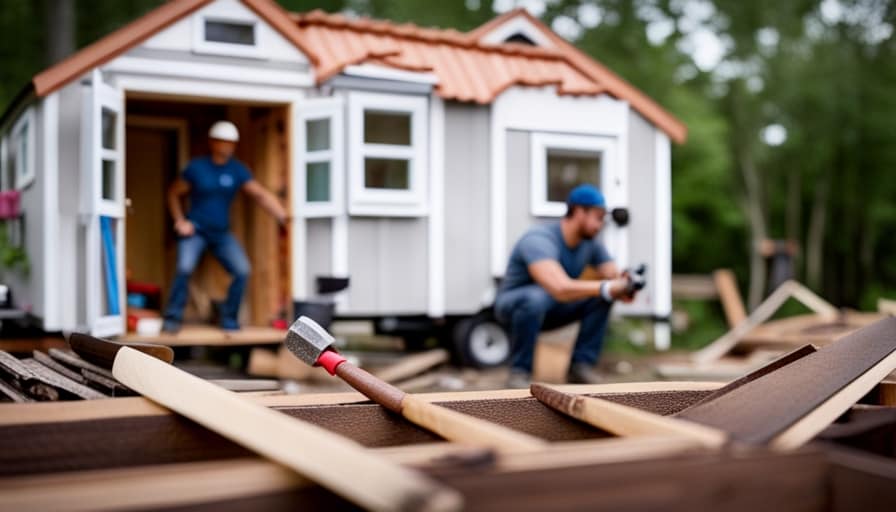
Through these initiatives, we aim to inspire collaboration, foster creativity, and build a supportive community for artists to thrive in.
The Eco-Friendly Oasis
When it comes to eco-friendly living, these tiny house communities have got it covered. They offer sustainable living options, such as composting toilets and rainwater harvesting systems, to minimize their environmental footprint.
Additionally, many of these communities have community garden initiatives and utilize renewable energy solutions, like solar panels, to promote a greener way of life.
Sustainable Living Options
We can create an eco-friendly oasis by adopting sustainable living options in our tiny house communities. Here are some ways we can promote sustainability:
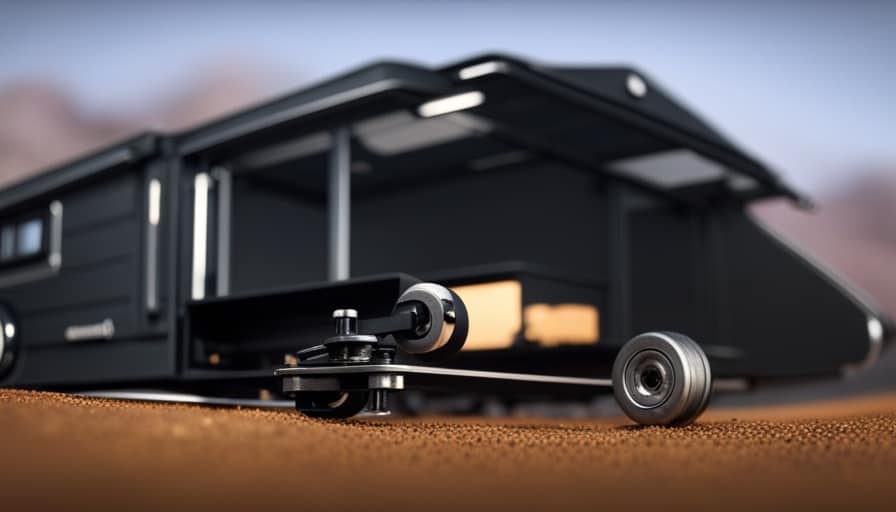
-
Sustainable Transportation: Encouraging residents to use bicycles or electric vehicles can reduce carbon emissions and promote a healthier lifestyle.
-
Zero Waste Lifestyle: Implementing recycling programs and composting facilities can help minimize waste and divert materials from landfills.
-
Energy-Efficient Practices: Installing solar panels and energy-efficient appliances can reduce energy consumption and lower utility costs.
-
Water Conservation: Promoting water-saving techniques like rainwater harvesting and greywater recycling can help conserve this precious resource.
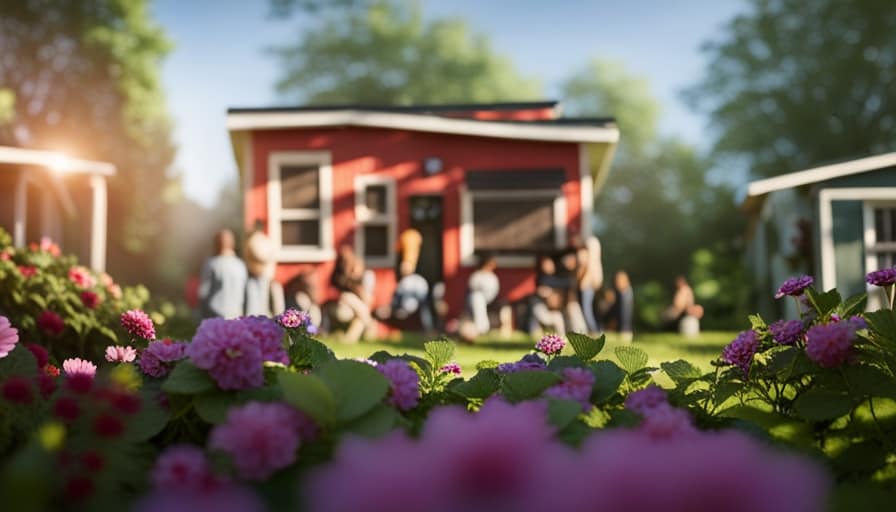
By embracing these sustainable living options, our tiny house communities can become models of environmental responsibility.
Now, let’s explore another aspect of creating a sustainable oasis: community garden initiatives.
Community Garden Initiatives
By regularly collaborating on community garden initiatives, we can transform our tiny house communities into eco-friendly oases.
Community engagement is a vital component of these initiatives, as it allows residents to come together and contribute to the development of urban farming practices within our communities.
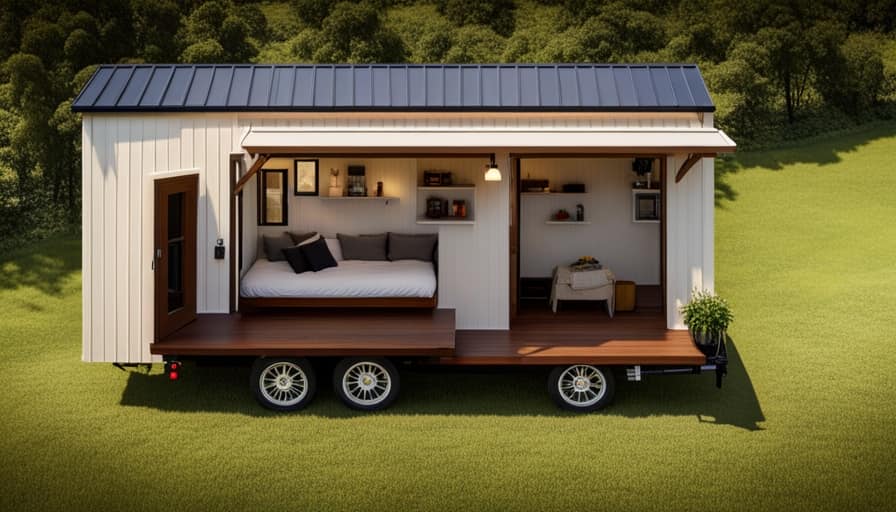
Urban farming provides an opportunity for individuals to grow their own food, reducing their reliance on external sources and promoting self-sustainability.
These community gardens not only serve as a source of fresh produce but also foster a sense of camaraderie and connection among residents.
Through shared responsibility and the cultivation of plants, our tiny house communities can become vibrant and sustainable spaces that prioritize environmental consciousness and the well-being of all members.
Let’s join hands and create these eco-friendly havens together.
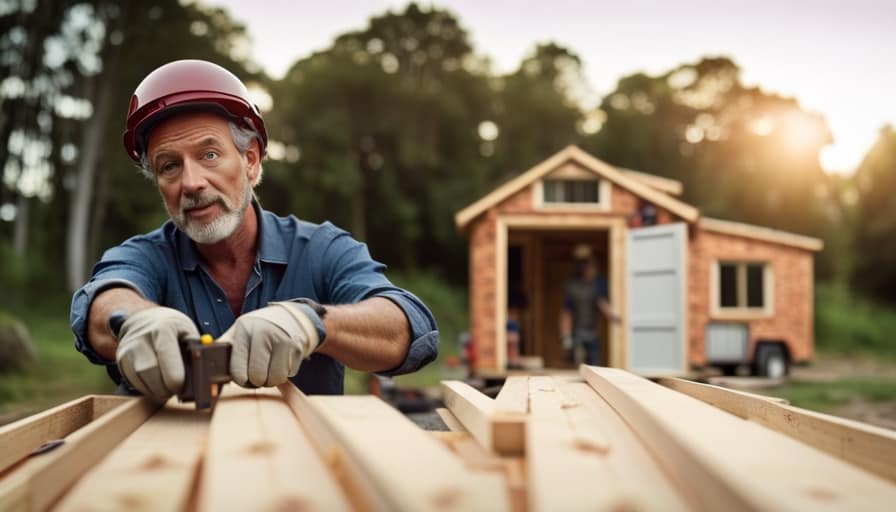
Renewable Energy Solutions
As residents of these tiny house communities, our collective efforts and the implementation of renewable energy solutions can transform our eco-friendly oasis into a model of sustainability. By incorporating renewable energy sources and energy-efficient design, we can significantly reduce our environmental impact and create a more sustainable future.
Here are some key ways we can achieve this:
-
Solar Power: Installing solar panels on our rooftops can harness the power of the sun to generate clean and renewable electricity.
-
Wind Energy: Utilizing wind turbines can capture the wind’s energy and convert it into electricity, providing another renewable energy source.

-
Energy Storage: Implementing battery storage systems can store excess energy generated from renewable sources, ensuring a reliable and continuous power supply.
-
Energy-Efficient Appliances: By using energy-efficient appliances and lighting, we can reduce our overall energy consumption and decrease our carbon footprint.
The Off-Grid Retreat
At the Off-Grid Retreat, we enjoy living in harmony with nature and rely on sustainable energy sources. Our community is dedicated to off-grid living and self-sufficiency, embracing a simpler and more eco-friendly lifestyle. We have created a peaceful haven where we can disconnect from the fast-paced world and reconnect with nature. Our retreat is powered by renewable energy sources such as solar panels and wind turbines, ensuring that we minimize our impact on the environment. We have also implemented rainwater harvesting systems and composting toilets to reduce our reliance on external resources. At the heart of our community, we have a communal garden where we grow organic fruits and vegetables, promoting self-sustainability and healthy living. Our off-grid retreat offers a unique opportunity to experience a simpler way of life while nurturing a deep respect for the environment.
| Feature | Description | Benefit |
|---|---|---|
| Renewable Energy | Solar panels, wind turbines | Sustainable power sources |
| Rainwater Harvesting | Collection and storage of rainwater | Reduces reliance on external water sources |
| Composting Toilets | Converts waste into compost | Decreases water usage and promotes resourcefulness |
| Communal Garden | Organic fruits and vegetables | Promotes self-sustainability and healthy living |
The Tiny House Co-op
In The Tiny House Co-op, we come together to support each other in our shared pursuit of minimalistic living. This tiny house co-living community provides a space where like-minded individuals can live in harmony and create a sense of belonging.
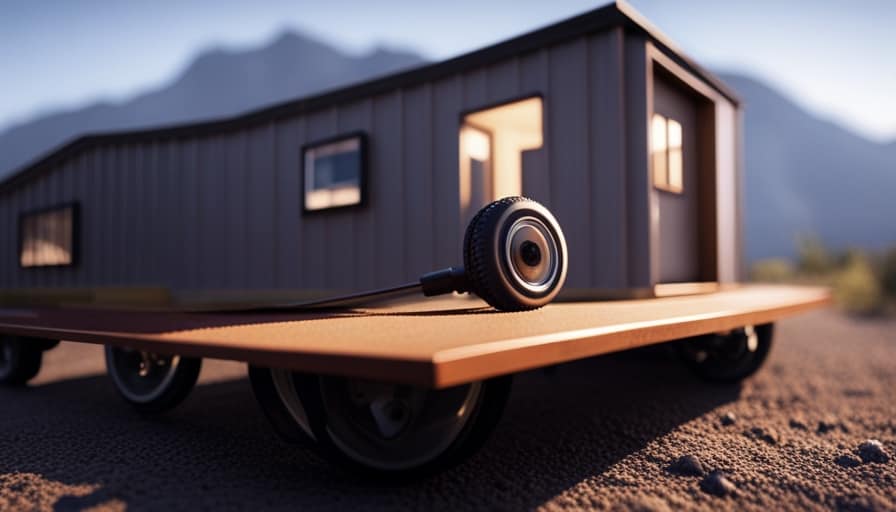
Here are some key features of The Tiny House Co-op:
-
Communal living spaces: We’ve common areas where residents can gather, socialize, and share resources. These spaces foster a sense of community and encourage collaboration among members.
-
Shared responsibilities: We believe in the power of teamwork and cooperation. Residents take turns in maintaining the community, from cleaning common areas to organizing events and workshops.
-
Resource sharing: Through resource sharing, we reduce our individual carbon footprint. From tools and appliances to garden supplies, we encourage borrowing and lending among community members.
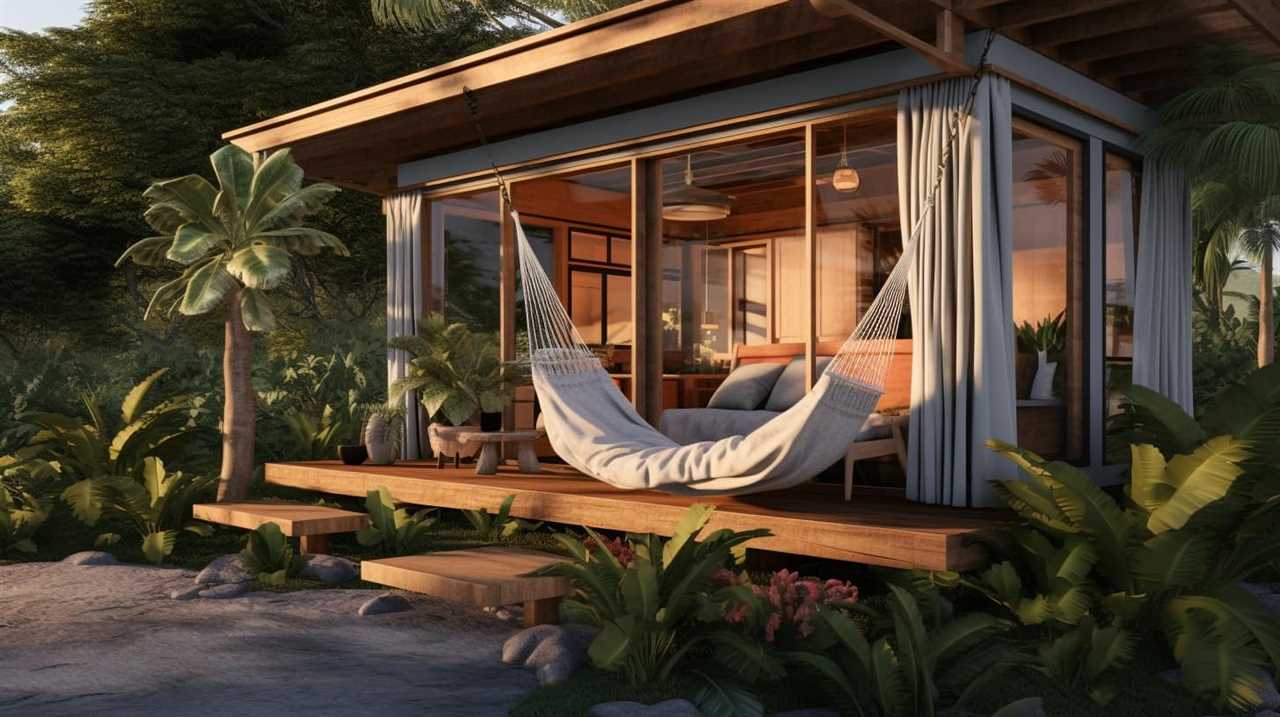
-
Supportive network: In The Tiny House Co-op, we prioritize the well-being of our members. We offer emotional support, guidance, and assistance to ensure everyone’s success in their minimalistic lifestyle.
As part of our commitment to sustainable living, we also have a community garden haven where residents can grow their own food and connect with nature.
The Community Garden Haven
The Community Garden Haven in tiny house communities offers a sustainable solution to food production. By sharing a garden, residents can grow their own fresh produce, reducing their reliance on store-bought groceries and promoting self-sufficiency.
This shared gardening experience not only provides access to healthier food options but also fosters a sense of community and connection among neighbors.
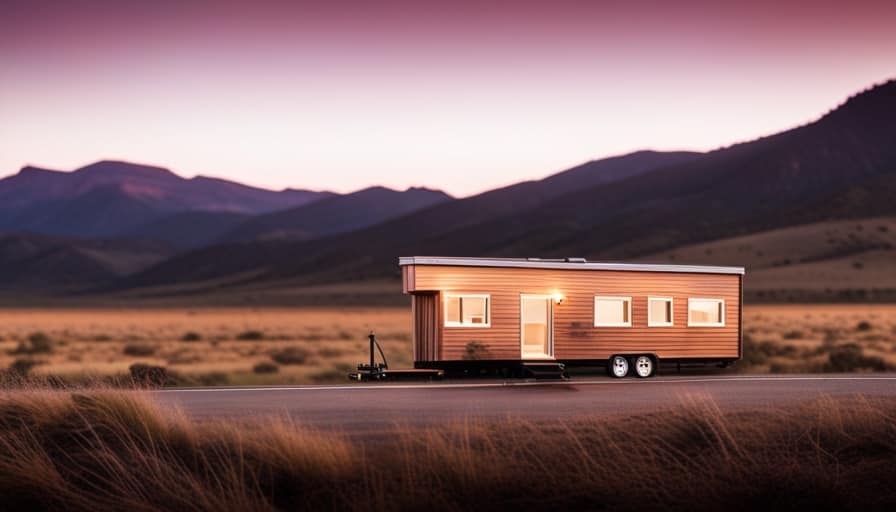
Sustainable Food Production
We actively participate in cultivating a sustainable food production system through our community garden haven. Our commitment to sustainable food production is evident in the following ways:
-
Urban farming: We utilize urban spaces to grow a variety of fruits, vegetables, and herbs, maximizing the use of available land.
-
Permaculture: Our garden is designed based on permaculture principles, creating a self-sustaining ecosystem that minimizes waste and promotes biodiversity.
-
Composting: We compost organic waste from our community, turning it into nutrient-rich soil for our garden beds, reducing the need for chemical fertilizers.

-
Water conservation: We implement water-saving techniques such as rainwater harvesting and drip irrigation to minimize water usage while ensuring the optimal growth of our crops.
By actively engaging in sustainable food production practices, we not only provide ourselves with fresh and healthy produce but also contribute to a more environmentally conscious and resilient community.
Now, let’s explore the benefits of shared gardening.
Benefits of Shared Gardening
By working together and sharing the responsibilities of gardening, our community not only fosters a sense of camaraderie but also reaps the benefits of a bountiful harvest.
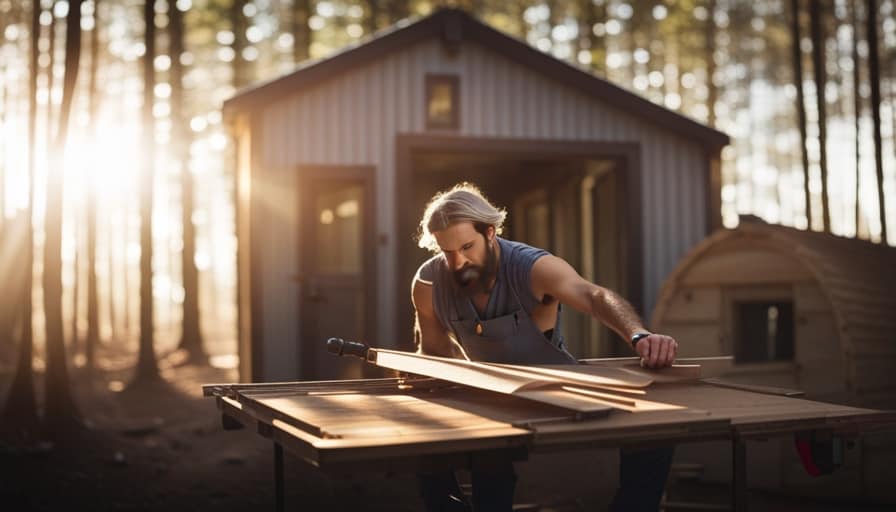
Shared gardening offers numerous benefits that strengthen our community connection. Firstly, it allows us to grow a variety of fruits, vegetables, and herbs that contribute to our collective food security. By pooling our resources and knowledge, we can cultivate a diverse range of crops, ensuring a steady supply of fresh and healthy produce for everyone.
Secondly, shared gardening promotes physical activity and outdoor engagement, improving our overall well-being. Gardening is a great way to stay active, relieve stress, and enjoy nature’s beauty.
Lastly, it provides an opportunity for skill-sharing and learning among community members. Through shared gardening, we can exchange gardening techniques, tips, and tricks, fostering a sense of empowerment and self-sufficiency.
The Wellness Sanctuary
Within the Wellness Sanctuary, we prioritize holistic well-being for all residents. Our community is designed to support individuals seeking a balanced and healthy lifestyle. Here, you’ll find a variety of wellness practices and opportunities to engage in holistic living.
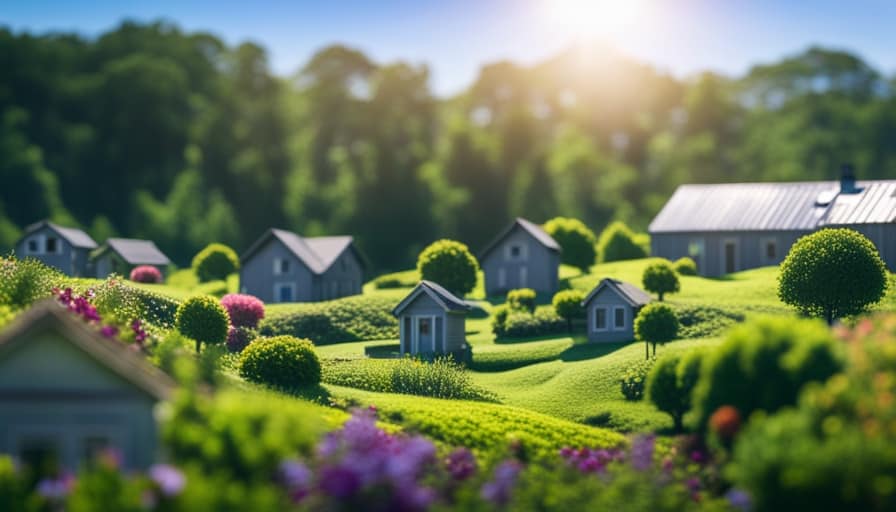
-
Daily Meditation: We offer guided meditation sessions to help residents cultivate mindfulness and reduce stress.
-
Yoga Classes: Our community provides regular yoga classes for all skill levels, promoting physical strength, flexibility, and mental clarity.
-
Nutrition Workshops: We believe that nourishing our bodies with wholesome foods is essential for overall wellness. Residents can participate in nutrition workshops to learn about healthy eating habits.
-
Nature Walks: Surrounding our sanctuary is a beautiful natural landscape. Residents can take leisurely walks to connect with nature and find solace in its calming presence.

Within the Wellness Sanctuary, we strive to create an environment that supports the well-being of all residents, fostering a sense of peace and harmony in their daily lives.
The Minimalist Village
Often overlooked but incredibly vibrant, the Minimalist Village offers a unique and simplified way of life for its residents. This community is at the forefront of the minimalist living movement, embracing the idea of downsizing and living with less. The tiny house movement has gained momentum in recent years, and the Minimalist Village is a prime example of this lifestyle choice.
With compact and efficient tiny homes, residents are able to focus on what truly matters to them, eliminating the distractions of excess possessions. The community fosters a sense of connection and support, with shared spaces and a strong emphasis on communal living. It’s a place where simplicity and mindfulness thrive, providing a haven for those seeking a more intentional and fulfilling lifestyle.
Transitioning from the Minimalist Village, let’s now explore the serene beauty of the tiny house waterfront village.
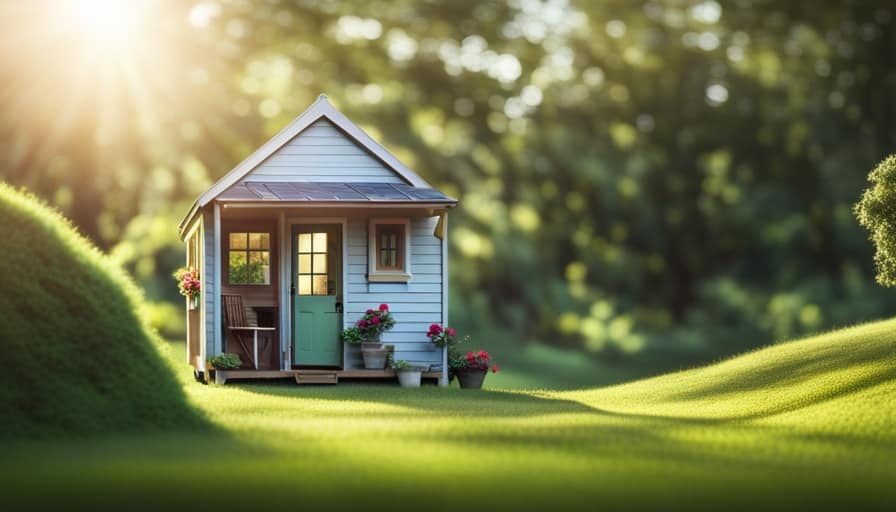
The Tiny House Waterfront Village
We’ve discovered that the Tiny House Waterfront Village isn’t only a hidden gem, but also a tranquil oasis for those seeking a serene and picturesque living environment.
Here are some key features of this waterfront community:
-
Scenic Views: The Tiny House Waterfront Village offers breathtaking views of the water, allowing residents to enjoy the beauty of nature right from their doorstep.
-
Waterfront Living: With its prime location along the water, this community provides residents with easy access to water activities such as boating, fishing, and swimming.

-
Community Atmosphere: The Tiny House Waterfront Village fosters a strong sense of community, where residents can connect with like-minded individuals and enjoy shared amenities.
-
Small Space Living: Living in a tiny house promotes a minimalist lifestyle, allowing residents to simplify their lives and focus on what truly matters.
For those seeking a peaceful and close-knit community, the Tiny House Waterfront Village offers the perfect blend of waterfront living and small space living.
Frequently Asked Questions
How Much Does It Cost to Live in a Tiny House Community?
Living in a tiny house community can be affordable. The cost of utilities is usually lower, and there are advantages like shared resources and a strong sense of community.
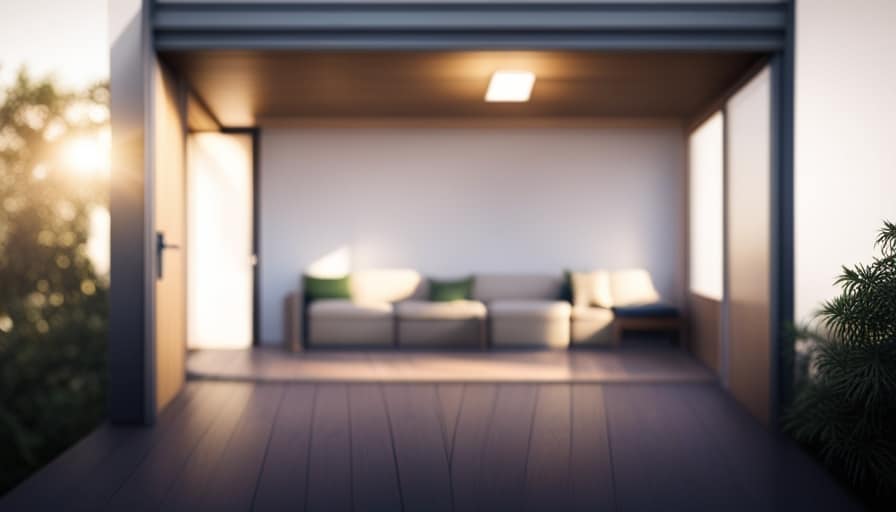
Are Pets Allowed in These Tiny House Communities?
Pets are allowed in many of these tiny house communities. They can have a positive impact on community dynamics, providing companionship and promoting a sense of community. Pet friendly environments offer numerous benefits for residents.
What Amenities Are Typically Included in These Tiny House Communities?
Tiny house communities typically include a variety of amenities such as community events, social activities, shared spaces, sustainable living practices, community gardens, eco-friendly infrastructure, access to public transportation, and proximity to urban amenities. Additionally, recreational facilities, co-working spaces, and communal kitchens and dining areas are often available.
Can I Customize the Design of My Tiny House in These Communities?
Yes, you can customize the design of your tiny house in these communities. There are various customization options and design flexibilities available, allowing you to create a personalized and unique living space.
Are There Any Age Restrictions for Living in These Tiny House Communities?
There may be age restrictions in some of these tiny house communities, as each community sets its own guidelines. It’s important to research and contact the specific communities you are interested in for more information on their age restrictions.

Conclusion
In conclusion, these top 10 tiny house communities offer a variety of unique and inspiring places to live.
From the pocket community that fosters a sense of togetherness, to the off-grid retreat that allows for a connection with nature, each community has its own charm.
Whether you’re seeking an eco-friendly oasis or a wellness sanctuary, these communities provide a minimalist and sustainable way of life.
So why not join the cohort of tiny house enthusiasts and find your perfect community today?
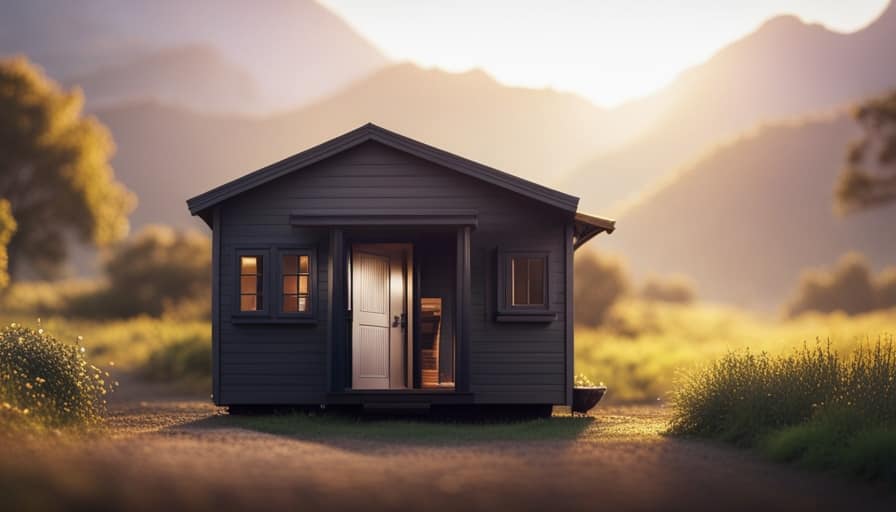
I’m Theodore, and I love tiny houses. In fact, I’m the author of Tiny House 43, a book about tiny houses that are also tree houses. I think they’re magical places where imaginations can run wild and adventures are just waiting to happen.
While tree houses are often associated with childhood, they can be the perfect adult retreat. They offer a cozy space to relax and unwind, surrounded by nature. And since they’re typically built on stilts or raised platforms, they offer stunning views that traditional homes simply can’t match.
If you’re looking for a unique and romantic getaway, a tree house tiny house might just be the perfect option.
